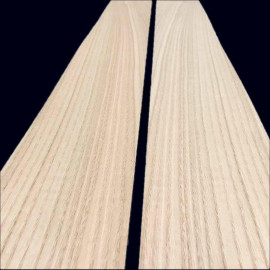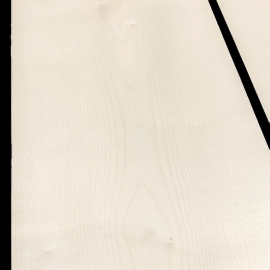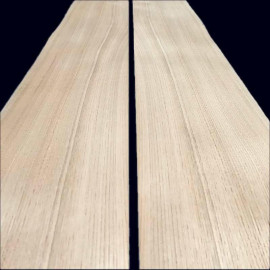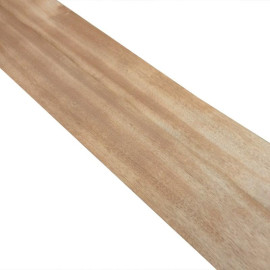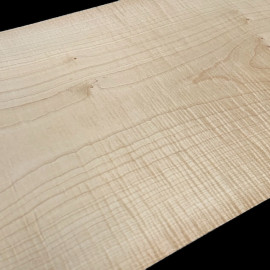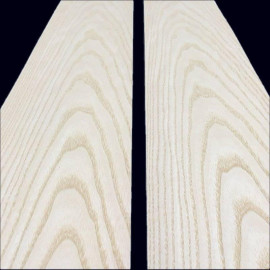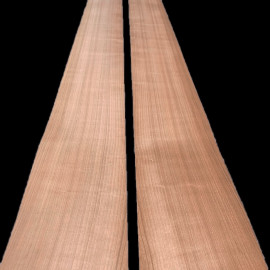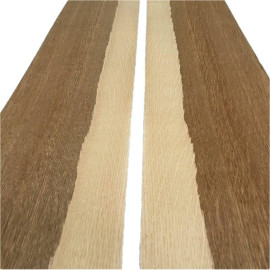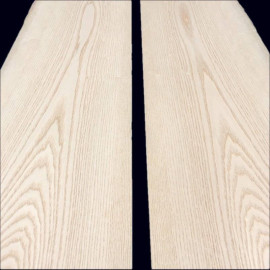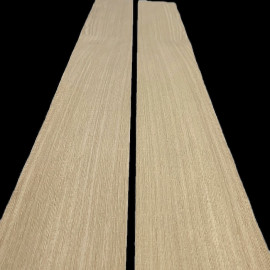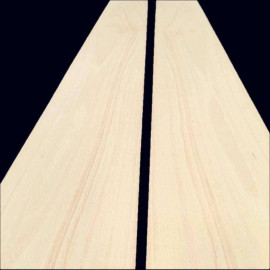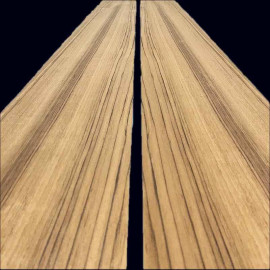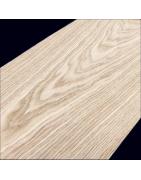
Half long veneers
Half-long genuine wood veneers.
Wood veneer sheets from 50 to 190 cm long.
These sliced veneers are ideal for covering a middle-sized realization, mainly 0.6 and 0.5 mm thick, but you may have some particular thicknesses, such as 0.3 and 0.9 mm.
For thicker veneers, please look at our thick veneers: THICK VENEERS.
Please use the species and dimensions filters on the left to help you to find the veneer you wish.
Active filters
Ivory White Plain Sycamore Veneer 50 x 31 cm
Ivory White Plain Sycamore Veneer 50 x 31 cm
Length: 50 cm.
Width: 31 cm.
Thickness: 0.6 mm.
Sold by the sheet.
Warning: These veneers are not dyed. They are naturally white but with a slightly ivory tint.
Pictures herewith are photos of the product you will receive.
Chestnut quarter-cut veneer 110 x 13 cm
Chestnut quarter-cut veneer 110 x 13 cm
Genuine wood sliced-veneer sheets.
Length: 110 cm.
Width: 13 cm.
Thickness: 0.55 mm.
Sold by the sheet.
Pictures herewith are photos of the product you will receive.
Okoume quarter-cut veneer 165 x 14 cm
Okoume quarter-cut veneer 165 x 14 cm
Genuine wood sliced-veneer sheets.
Length: 165 cm.
Width: 14 cm.
Thickness: 0.5 mm.
Sold by the sheet.
Pictures herewith are photos of the product you will receive.
Natural Golden Weathered Figured Sycamore...
Natural Golden Weathered Figured Sycamore Veneer 50 x 31 cm
Length: 50 cm.
Width: 31 cm.
Thickness: 0.6 mm.
Sold by the sheet.
These veneers are not dyed. Their natural color is said to be "white" but is closer to ivory. Over time, this ivory color becomes golden.
Pictures herewith are photos of the product you will receive.
- On sale!
White Ash crown-cut veneer 75 x 13 cm
White Ash crown-cut veneer 75 x 13 cm
Genuine wood sliced-veneer sheets.
Length: 75 cm.
Width: 13 cm.
Thickness: 0.6 mm.
Sold by the sheet.
Pictures herewith are photos of the product you will receive.
- On sale!
French Cherry Quarter-cut Veneers 150 x 15 cm
French Cherry Quarter-cut Veneers 150 x 15 cm
Genuine wood sliced-veneer sheets.
Length: 150 cm.
Width: 15 cm.
Thickness: 0.55 mm.
Sold by the sheet.
Pictures herewith are photos of the product you will receive.
Brown Oak quarter-cut veneer 90 x 18 cm
Brown Oak quarter-cut veneer 90 x 18 cm
Genuine wood sliced-veneer sheets.
Length: 90 cm.
Width: 18 cm.
Thickness: 0.6 mm.
Sold by the sheet.
Pictures herewith are photos of the product you will receive.
White Ash crown-cut veneers 100 x 26 cm
White Ash crown-cut veneers 100 x 26 cm
Genuine wood sliced-veneer sheets.
Length: 100 cm.
Width: 26 cm.
Thickness: 0.6 mm.
Sold by the sheet.
Pictures herewith are photos of the product you will receive.
- On sale!
Lati Veneers 150 x 15 cm
Lati Veneers 150 x 15 cm
Genuine wood sliced-veneer sheets, in sequence.
Length: 150 cm.
Width: 15 cm.
Thickness: 0.55 mm.
Sold by the sheet.
These photos are taken from the veneer sheets you will receive.
Beech crown-cut veneer 140 x 14 cm
Beech crown-cut veneer 140 x 14 cm
Genuine wood sliced-veneer sheets.
Length: 140 cm.
Width: 14 cm.
Thickness: 0.6 mm.
Sold by the sheet.
Pictures herewith are photos of the product you will receive.
Teak quarter-cut veneer 155 x 15 cm
Teak quarter-cut veneer 155 x 15 cm
Genuine wood sliced-veneer sheets.
Length: 155 cm.
Width: 15 cm.
Thickness: 0.5 mm.
Sold by the sheet.
Pictures herewith are photos of the product you will receive.
 English
English


